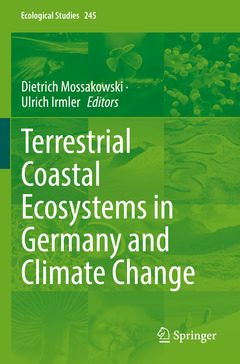Terrestrial Coastal Ecosystems in Germany and Climate Change, 2023 Ecological Studies Series, Vol. 245
Coordonnateurs : Mossakowski Dietrich, Irmler Ulrich

Part I. Introduction and Description of Study Area.- Chapter 1. Introduction.- Chapter 2. Climate Changes Along the German Coast.- Chapter 3. Coastal Landscapes of the North Sea and the Baltic Sea.- Chapter 4. Geography and Study Sites.- Chapter 5. Climate and Weather Conditions Along the German Shores.- Chapter 6.- Inundation Regimes of the German Coasts and the Impact of the Rising Sea Level.- Chapter 7. The Surface Salinity of the North Sea and Baltic Sea Area.- Chapter 8. Soils.- Part II. Historical and Future Changes of the Dune and Salt Marsh Fauna.- Chapter 9. General Aspects of Coastal Vegetation at the North Sea and the Baltic Sea.- Chapter 10. Predicting Plant Distribution Shifts.- Chapter 11. General Aspects of Coastal Carabid Beetle and Spider Fauna at the North Sea and the Baltic Sea.- Chapter 12. Changes of the Fauna of Digger Wasps and Bees (Hymenoptera, Aculeata) of the North Frisian Island of Sylt – Effects of Climate Change?.- Chapter 13. Historical Changes in the Carabid Beetle Fauna of Mecklenburg-Western Pomerania.- Chapter 14. Distribution of Spiders and Carabid Beetles Along a Geographical Gradient.- Chapter 15. Predicting Carabid Beetle Distribution Shifts.- Part III. Experimental Assessments of the Effects of Climate Change on Habitats and Their Organisms.- Chapter 16. Field Experiment: Effects of Increased Temperature on a Tidalic Fluvisol.- Chapter 17. Field Experiment: Effects of Microclimate Modification on Soil Organisms and Aggregate Formation in Dune Sand.- Chapter 18. Expected Vegetation Dynamics in Salt Marshes at the North Sea Coast Under Changed Inundation Conditions as an Effect of Climate Change.- Chapter 19. Effects of Sedimentation and Erosion on the Development of Vegetation.- Chapter 20. Tide Simulation Experiment.- Chapter 21. Storm Surges as Natural Experiments.- Part IV. De-Embankments and Its Effects on the Vegetation and Fauna.- Chapter 22. De-embankments at the North Sea and the Baltic Sea Coasts.- Chapter 23. Salt Marsh Restoration in a Summer Polder at the Wursten Coast.- Chapter 24. Estimated Future Effects of the Sea Level Rise Exemplified by the Wursten Coast.- Chapter 25. Restoration of Salt Meadows at the Baltic Sea Coast: The De-Embankment Experiment at Karrendorf Meadows.- Part V. Synthesis and Conclusions.- Chapter 26. Expert System: Plants.- Chapter 27. Expert System: Spiders and Carabid Beetles. Chapter 28. Consequences of Climate Change for Biota of the Coastal Salt Marshes and Dunes: Synthesis, Final Conclusions, and Ideas of Compensation.
Date de parution : 03-2024
Ouvrage de 480 p.
15.5x23.5 cm
Date de parution : 03-2023
Ouvrage de 480 p.
15.5x23.5 cm
Thèmes de Terrestrial Coastal Ecosystems in Germany and Climate Change :
Mots-clés :
Arthropoda; Baltic Sea; Carabidae; Carabid Beetles; Climate Change; Coastal Ecosystems; Coastal Planning; Coastal Vegetation; Elevation Gradients in Salt Marshes; Erosion; Impacts of Temperature on Plants and Animals; North Sea; Plant and Animal Distribution Changes; Reactions of Coastal Arthropods After De-embankment; Reactions of Coastal Ecosystems After De-embankment; Sedimentation; Spiders



